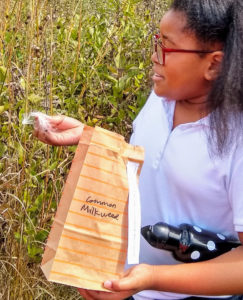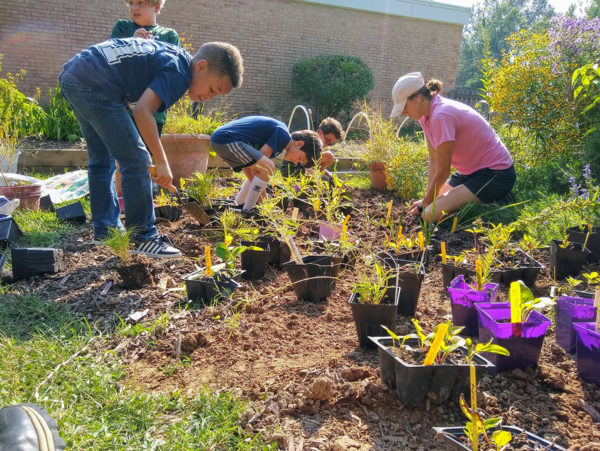As they exited the school building, Kim’s students spread out in the schoolyard to their personal observation spots where they each pulled a mat, journal and colored pencils out of their tote bag and settled in for a period of quiet observation and journaling. The goal was getting to know their schoolyard as a habitat: its plants and animals, highs and lows, wet and dry spots, sun and shade, where it’s fun and where it’s boring. In so doing, they were embarking on their mission of creating a schoolyard natural habitat, a Sustainable Schoolyard.
How do they know what a St. Louis natural habitat looks like? Kim and her students visited a nearby nature space to get familiar with native plants and animals: Litzsinger Road Ecology Center.
What follows is a summary of Kim’s reports and experiences over the past couple of years in the form of an interview.
 Eddie: Tell me how your students became familiar with native plants.
Eddie: Tell me how your students became familiar with native plants.
Kim: During our fall visit to LREC, the kids explored the habitats—discovering the diversity of colors, textures and patterns displayed by plants. They also collected seeds from some of the plants in the woods and prairie. We learned how to recognize the way seeds travel and their amazing and unique structures.
Eddie: What did your students do with the seeds that they collected?
Kim: Back at school, we separated the seeds from other plant parts and then learned how to give them a fake winter experience by putting them in the refrigerator with some soil and water for a while. While the seeds were “sleeping,” the students began planning their own schoolyard habitat. We used pictures of plants and information sheets to select plants and design our outdoor space. We made our decisions based on plant size, bloom color and timing, moisture and light requirements and wildlife benefit. The kids’ favorite plant was cardinal flower, known to attract hummingbirds.
Eddie: Let’s get back to those sleeping seeds. What did you do next with them?
Kim: Once I reminded the kids that we had some sleeping seeds, they were eager to wake them up. This is how we did that. We planted the seeds in some small plant containers provided by LREC. We gave them a warm, sunny place in the classroom and made sure that they had enough water. The students were so excited to watch them grow. In the spring, we brought our plants to LREC where we planted them in larger containers and left them with our Litzsinger friends over the summer. We decided to do this because we realized that it was going to be difficult to care for these delicate young plants over the summer when we would not be around to tend to them.
Eddie: Knowing that the plants would be returned to you in the fall, what did you do to get the schoolyard ready for them?
Kim: The students noticed that the future habitat was covered in lawn grass that needed to be removed. Instead of pulling it all out—that would be hard work!—the students covered the space with cardboard brought from home. They also decided to cover the cardboard with garden mulch to make it look nicer. This stayed in place throughout the spring and summer. In the fall, we removed the cardboard and discovered that we had successfully killed the grass, making space for our native plants. Our plants were collected from LREC and planted by my incoming students, introducing them to our emerging schoolyard habitat.
Eddie: So what happens next?
Kim: I plan to have the class regularly investigating our schoolyard habitat in order to become familiar with its plants and animals. As the year progresses the class will explore ways to manage, improve and learn from this kid-friendly area of our schoolyard. I’m looking forward to the new class taking ownership of the space as I experienced with last year’s class. Outdoor learning has proven to be so effective with my class that I’m reaching out to other teachers, inviting them to get outside with their students.
Eddie: Why are you creating a Sustainable Schoolyard?
Kim: This process has given my students a chance to make the schoolyard a more inviting place for people and animals. In doing so, we are addressing curriculum goals in language arts, science and math as well as the physical and emotional benefits of active, outdoor learning. By taking an active role in enhancing the quality of their schoolyard, they have also taken an active role in their learning as well as educating the broader community.
Are you ready to embark on this journey with your students? If so, join us for Sustainable Schoolyards this summer.

